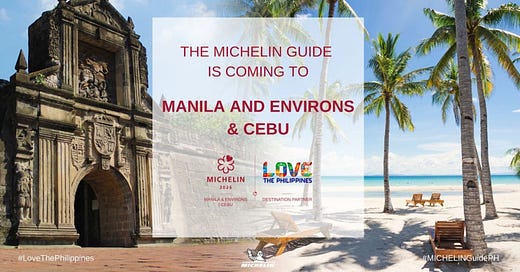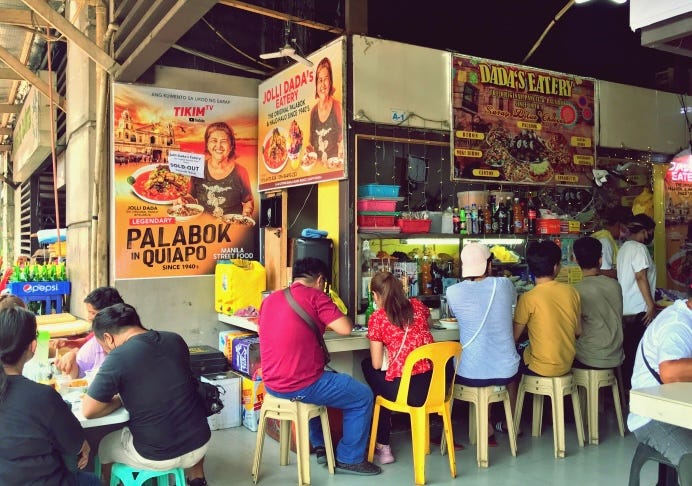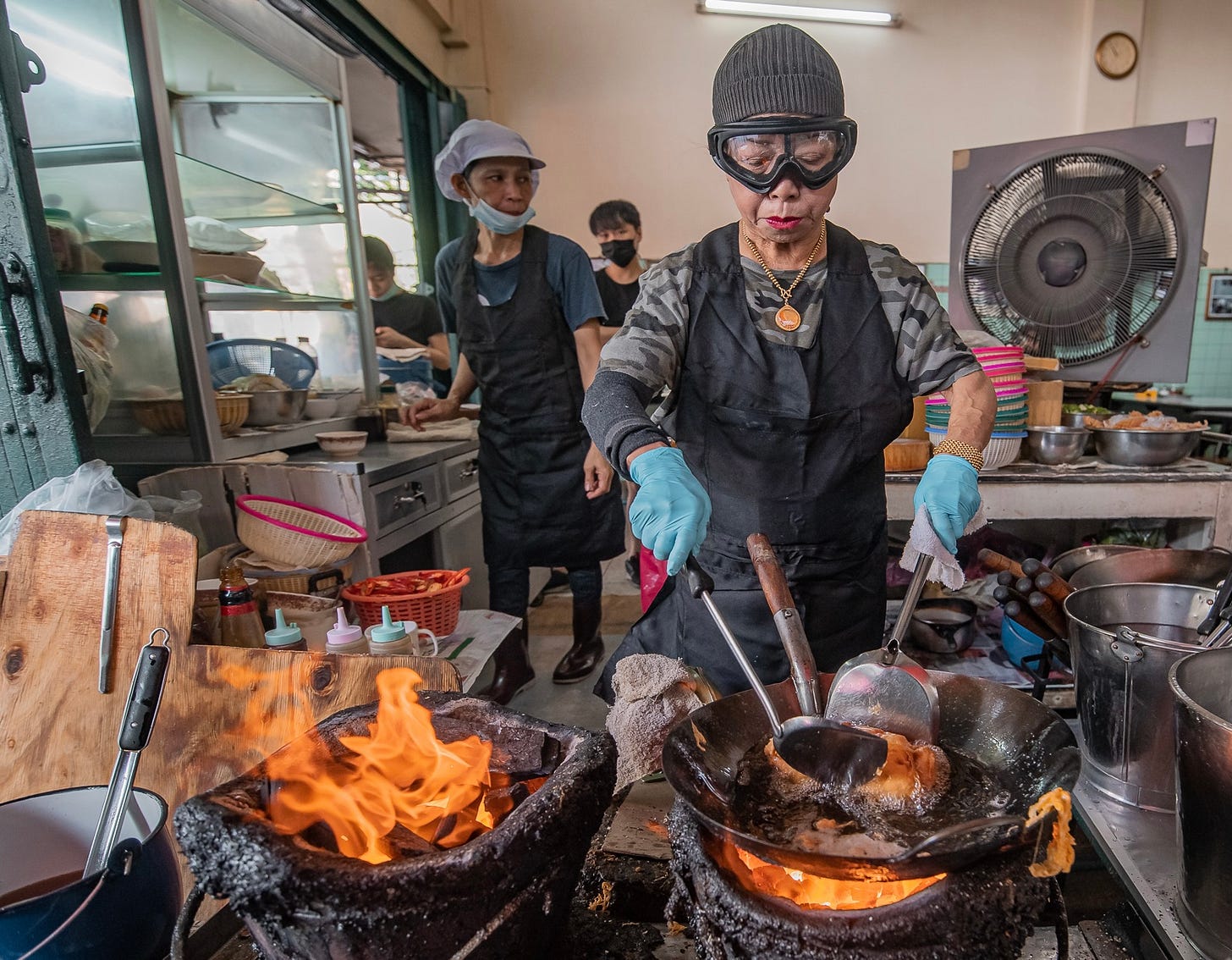By now, you’ve probably seen the headlines. The Michelin Guide has officially announced its expansion into the Philippines, with its inaugural edition set to cover Manila and Environs & Cebu. The press releases will frame it as a historic milestone, and the discussions will centre on which restaurants might receive stars or Bib Gourmands and what this recognition could mean for the global perception of Filipino cuisine.
There’s no doubt this is a significant moment. But beyond the headlines and the inevitable excitement, there’s a deeper conversation we need to have.
Michelin’s presence in the Philippines will shine a spotlight on our culinary landscape, but recognition alone does not define a cuisine. The more important question is who gets to shape the story of Filipino food? Will this moment highlight the full breadth of our cuisine from fine dining to the everyday soul of carinderias and turo-turo stalls or will it narrow the focus to a select few?
Filipino food has thrived through colonial history, migration, and reinvention, not because it sought external validation, but because it has always been deeply rooted in our communities. Now, as Michelin’s inspectors explore the country, we must ask: what version of Filipino cuisine will they see, and what stories will remain untold?
A Cuisine at the Crossroads
“A Filipino may denationalise himself but not his stomach. He may travel over the seven seas, the five continents, the two hemispheres and lose the savour of home, forget his identity and believe himself a citizen of the world. But he remains—gastronomically, at least—always a Filipino.” — Carmen Guerrero Nakpil
Filipino cuisine does not need to be introduced to the world, it is already there. In Chicago, Kasama became the first Michelin-starred Filipino restaurant, proving that our food could command a fine dining space without apology. In Melbourne, Serai and Askal earned industry nods, with chefs unafraid to cook Filipino food their way. In London, Donia received a Michelin Bib Gourmand, solidifying its place in the city’s dining scene and showing that Filipino food can stand alongside the best of London’s globally diverse offerings.
And in the Philippines itself, there is Toyo Eatery, where Jordy Navarra distills the essence of Filipino flavours with a storyteller’s precision. There is Metiz, redefining what modern Filipino food can be. There is Sarsa, where JP Anglo serves dishes with the confidence of a chef who knows his roots are not a limitation but a foundation.
Last year, I was lucky enough to eat at some of Manila’s most coveted fine dining spots, Toyo, Metiz, Hapag, Inato, Linamnam, restaurants that could rival any Michelin-starred establishment I’ve ever experienced. But they represent just one side of Filipino cuisine.
The beauty of Filipino cuisine, however, is that excellence isn’t confined to fine dining. The joy I had when eating bulalo in Tagaytay, the perfectly balanced adobong pusit and the meticulous yet unpretentious isaw at Sarsa, and of course, the smoky, charred perfection of inasal (paa, of course!) at C.H.E Bacolod Chicken House Express, these experiences were just as soulfully felt as their fine dining counterparts. The food and cooking, in my mind, were exceptional and worth the journey.
Yet, the heart of Filipino cuisine beats strongest in places that rarely make it to lists or guides.
At Monchie’s Lechon, pork crackles under a slow-roasted skin, the smoky richness a testament to time-honoured tradition. At Milky Way, classic dishes like kare-kare and halo-halo have defined generations of Filipino dining. Meanwhile, at Jolli Dada’s Eatery, their pancit palabok laden with shrimp-infused sauce, crushed chicharon, adobong pusit, and crisp chicharon bulaklak delivers bold, savoury flavours in a setting that proves some of the best Filipino food exists far from fine dining rooms, in spaces where flavour speaks louder than presentation. Michelin may grant stars, but it does not dictate where food lives
Validation, Recognition, and the Weight of Michelin
The Michelin Guide does not create excellence, it acknowledges what already exists. But its arrival carries weight. Recognition from institutions like Michelin has a way of narrowing focus, drawing attention to one type of experience while letting others slip into the periphery.
That said, Michelin’s presence has, at times, led to greater awareness and investment in local cuisines. In Bangkok, its initial focus on fine dining eventually expanded to include street food, with legendary vendor Jay Fai receiving a star. In Singapore, hawker stalls like Hill Street Tai Hwa Pork Noodle and Hong Kong Soya Sauce Chicken Rice & Noodle were recognised. While Michelin’s selection process remains opaque, there has been discussion within Singapore’s hawker community about whether more of its vibrant street food culture deserves recognition.
Since the Michelin Guide launched in Thailand in 2017, Bangkok’s culinary scene has continued to gain global attention, with food tourism playing an increasingly prominent role, bolstered by Michelin’s presence alongside broader government-led gastronomy tourism efforts. However, Michelin’s impact has been complex. Some street food vendors saw a surge in customers, while others faced challenges from rising rents and shifting customer demographics, pressures largely driven by urban redevelopment policies, though Michelin’s increased visibility may have influenced certain areas.
The real question is not just whether Michelin will capture the full spectrum of Filipino cuisine, but whether Filipino chefs and food businesses will choose to embrace, challenge, or redefine this moment on their own terms.
The Role of Government: A Missed Opportunity, or a New Beginning?
Thailand understood early that food was a national asset. The Global Thai initiative, launched in 2002, was a masterclass in culinary diplomacy, providing funding, training, and marketing support to Thai restaurants worldwide. The result? Thai food is one of the most globally recognised Asian cuisines today, embedded in the mainstream dining culture of cities across the world.
Instead, the Philippines has taken a different path, one not shaped by government initiatives, but by the resilience of its people.
Of course, food diplomacy is not a one-size-fits-all strategy. Thailand’s model succeeded because it was built on an already strong tourism industry and a cuisine with early global appeal. The challenge for the Philippines is to develop a strategy that plays to its own strengths, one that not only supports grassroots food businesses, including farmers and growers, but also strengthens supply chains and ensures that Filipino cuisine has long-term visibility beyond fleeting trends.
Unlike Thailand’s government-led approach, the global spread of Filipino cuisine has been largely organic. It has been fuelled by millions of Overseas Filipino Workers (OFWs) sharing the flavours of home, alongside Filipino chefs, restaurateurs, and entrepreneurs who have introduced the cuisine to new markets.. In cities from Dubai to Toronto, from Hong Kong to Los Angeles, Filipino food has taken root not in government-funded campaigns, but in homes, community gatherings, and mom-and-pop eateries run by migrants sharing a taste of home. Whether in informal canteens in the Middle East, food trucks in Australia, or thriving Filipino neighbourhoods in North America and Europe, our cuisine has grown organically, sustained by migration, resilience, and a deep connection to identity.
This grassroots-driven expansion is a unique strength, not a weakness, but without a coordinated national effort, Filipino cuisine risks remaining a diasporic success rather than a fully recognised global cuisine. The question now is how the Philippines can harness this existing global footprint to build a more strategic, long-term approach, one that not only amplifies and sustains our food culture, but ensures it takes its rightful place in the global culinary conversation.
What Comes Next?
There is no doubt that Michelin’s arrival in the Philippines will change things. Some restaurants will gain new audiences, some will pivot to meet expectations, some will remain resolutely the same. But the real test of this moment is not just how many stars are handed out, it’s whether the world finally sees Filipino food in its full, unapologetic spectrum, beyond just the polished plates of fine dining.
On a personal level, I couldn’t be happier to see some of my culinary heroes and inspirations finally receiving the recognition they deserve. Seeing chefs I admire, chefs who have pushed, fought, and dedicated themselves to Filipino food for years, earn their Michelin stars is a powerful moment. Their work was always exceptional, long before an inspector’s notebook landed on their tables. Michelin’s recognition is meaningful, but it is not what makes their food great. Filipino food has always been worthy of praise, of celebration, of being at the centre of the global table. Michelin may acknowledge that now, but it was never the gatekeeper of its value.
Still, I know what this moment means for the industry, and I won’t pretend otherwise. No matter how anyone feels about Michelin’s role in shaping culinary narratives, I’ll be watching when the awards are announced, just as I did for the UK & Ireland ceremony. Because at the end of the day, I am a chef first and a writer second. I love this industry, and I love our cuisine even more. Seeing my friends, peers, and those I admire receive recognition for years of hard work, sacrifice, and passion? That’s something I will always celebrate.
The Michelin Guide will not define the future of Filipino food but it can be a catalyst. A spark. A reason for more people to look closer, to dig deeper, to taste beyond what they think they know.
Filipino food was never waiting for permission. Michelin’s recognition does not make it valid, it always was. But maybe, just maybe, this is the moment the world finally realises it.









“The more important question is who gets to shape the story of Filipino food? Will this moment highlight the full breadth of our cuisine from fine dining to the everyday soul of carinderias and turo-turo stalls or will it narrow the focus to a select few?”
😭😭😭🙏🙏🙏
I love this piece! especially what you said about Filipino cuisine being a diasporic success because this is what I feel now. I also agree what you said about the heart of the Filipino cuisine beating the most in places that rarely make it to lists or guides. For example here in Cebu, the Sioma sa Tisa, Lechon in Carcar market or Talisay, or the bakasi in Cordova. These are rarely pretty spots but places where the locals actually go to.
Also saved this post as well for whenever I get the chance to be in Manila.